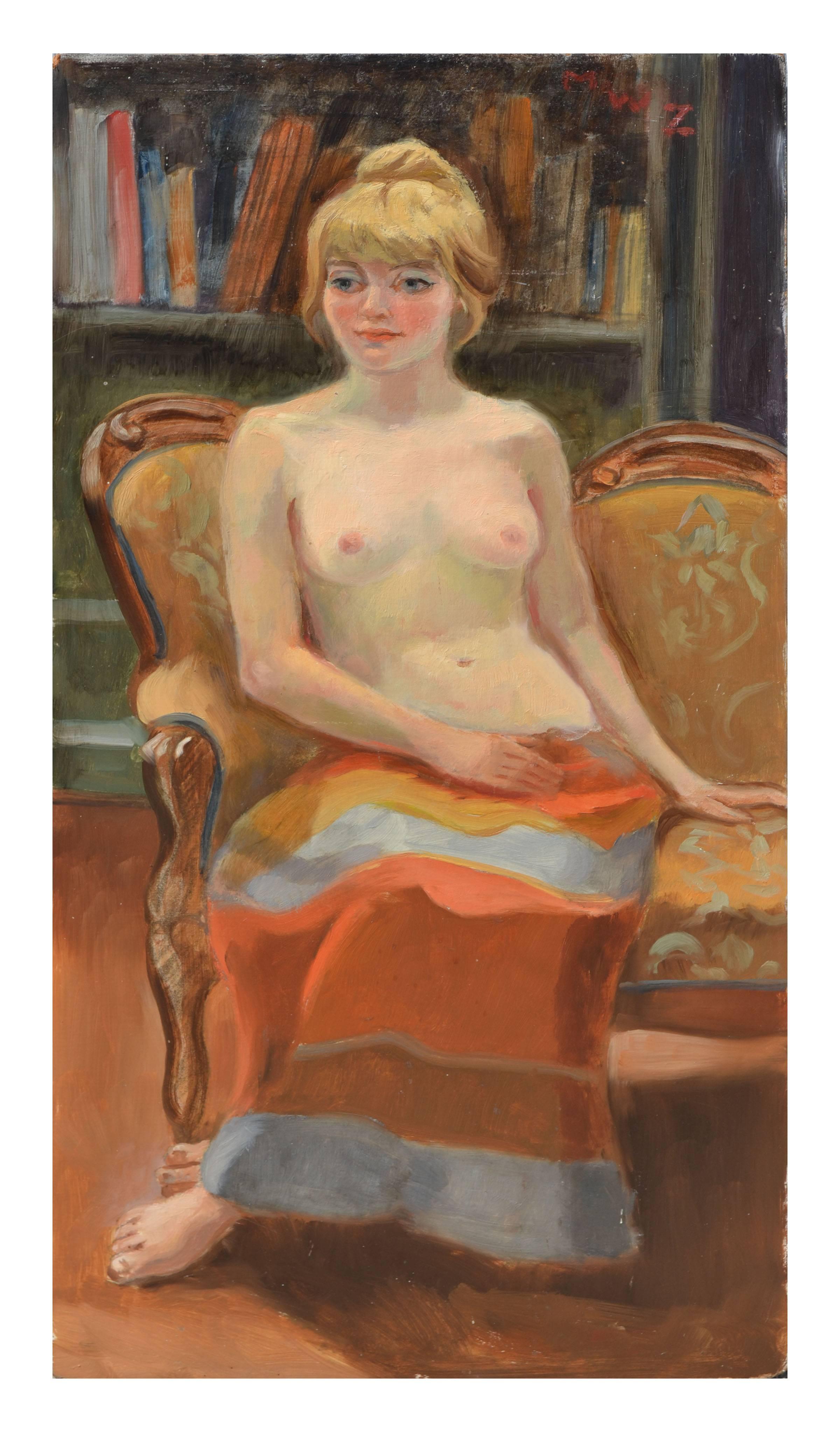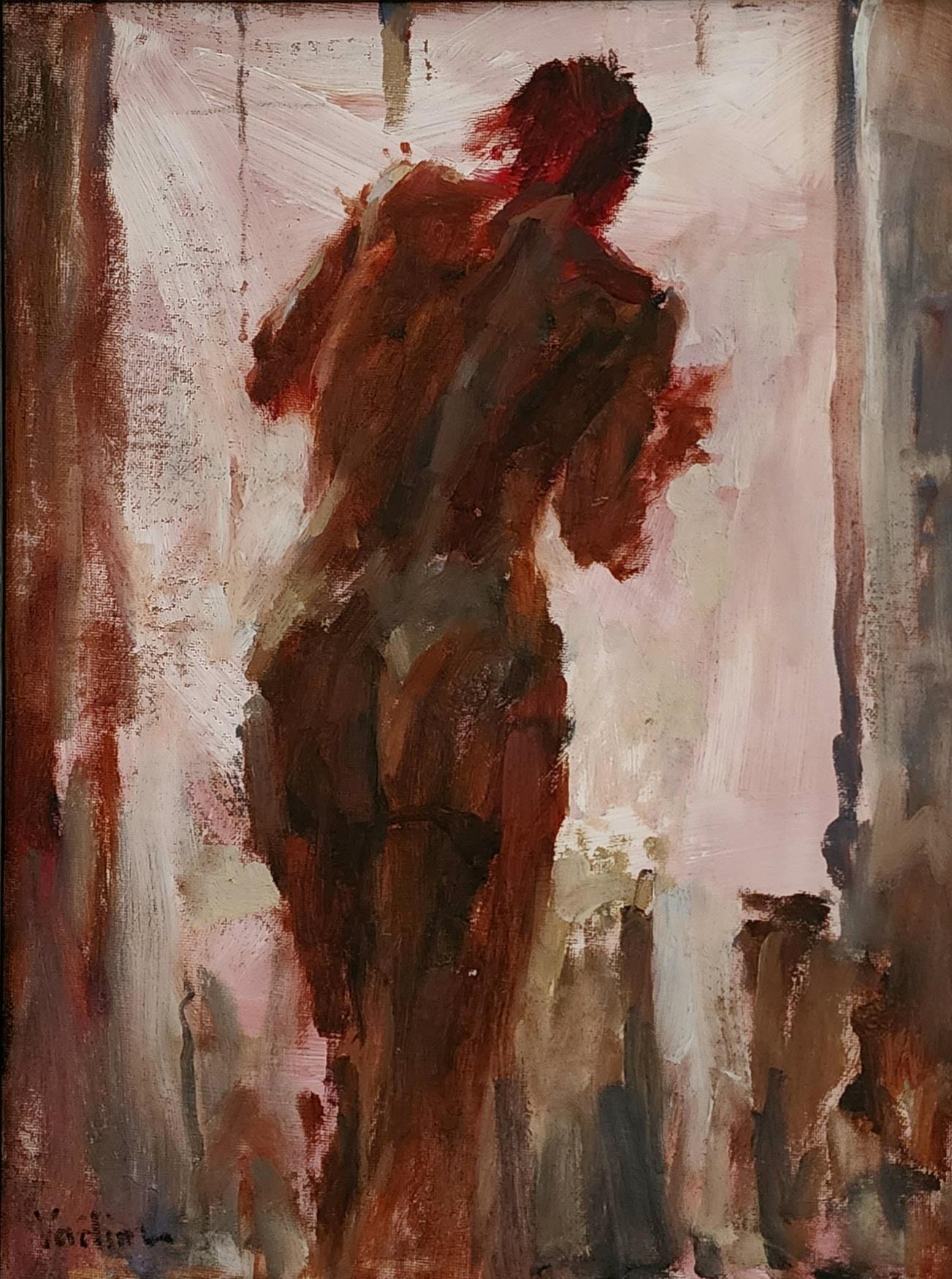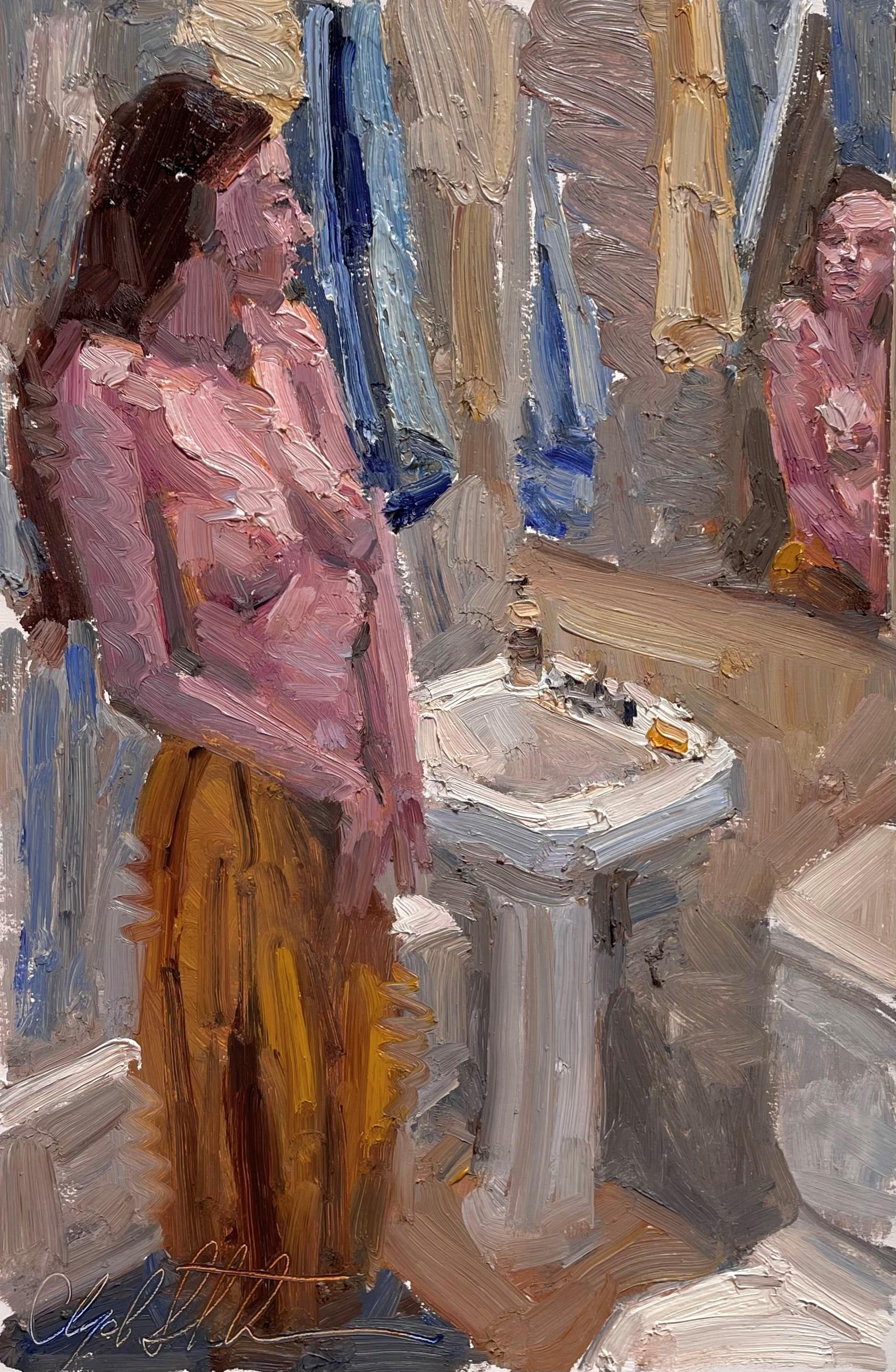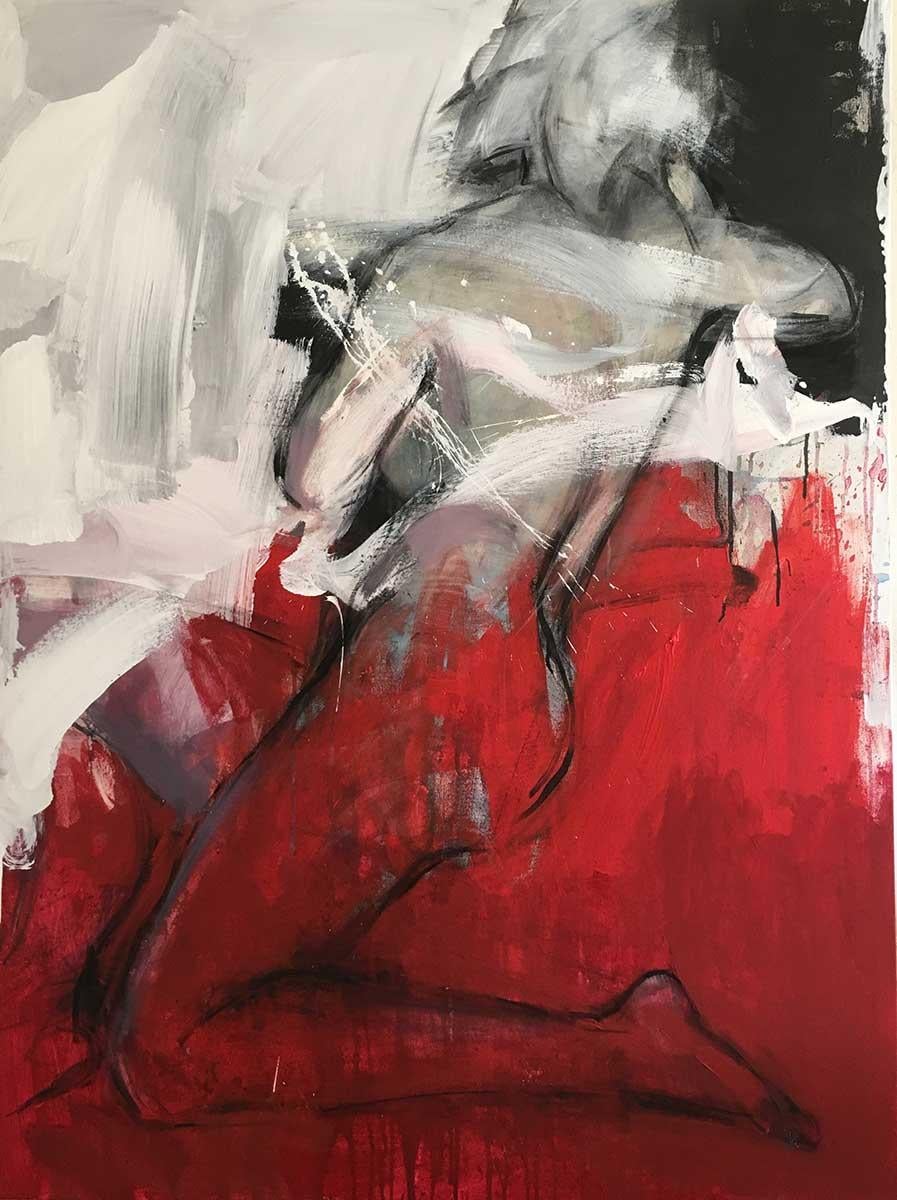Jon BlanchetteMid Century Female Nude Figure, Sea Cliff Beach
About the Item
- Creator:Jon Blanchette (1908-1987, American, British)
- Dimensions:Height: 31 in (78.74 cm)Width: 24 in (60.96 cm)Depth: 2 in (5.08 cm)
- Medium:
- Movement & Style:
- Period:
- Condition:
- Gallery Location:Soquel, CA
- Reference Number:
Jon Blanchette
Jon Blanchette was born in Somerset, England, in 1908. He immigrated to Battle Creek, Michigan, in 1918. Artistically inclined at age six, he later studied at the Pittsburgh Art Institute, where he received his BA. In 1932, Blanchette moved to Los Angeles, where he painted, did the architectural design, interior decorating and stage sets for Fox Studios. In 1948, he settled in Aptos, California, where he painted fine art and taught privately. During the summers of 1965–75, Blanchette held workshops in Mendocino. A romantic realist, he was primarily an oil painter but was also proficient with pen & ink, watercolor, and silkscreen. Blanchette died in Aptos in 1987. He had a membership for the Santa Cruz Art League and Marin County Artists. Blanchette exhibited at Santa Cruz Women's Club, 1959, and stood first in the Santa Cruz County Art Competition, Aptos Art Center, 1965.
(Biography provided by Robert Azensky Fine Art)- ShippingRetrieving quote...Ships From: Soquel, CA
- Return PolicyA return for this item may be initiated within 14 days of delivery.
- Demure Nude Figurative in Library by Margaret Wherry ZieglerBy Margaret Wherry ZieglerLocated in Soquel, CAA nude portrait of a demure young lady seated on an antique couch in a library setting by Margaret Wherry Ziegler (American, 1909-1989). Signed with monogram "MWZ" top right, and on verso. Unframed. Image, 24"H x 12"L. Ziegler studied at Cincinnati Art Academy, Minneapolis Art...Category
1970s American Impressionist Nude Paintings
MaterialsMasonite, Oil
- Mid Century Nude Study, Reclining Figure on BlueBy Jon BlanchetteLocated in Soquel, CAMid Century nude study of a female figure in a reclining pose with a rich blue background by listed artist Jon Blanchette (American, 1908-1987). Signed "Blanchette" lower right. Unf...Category
1960s American Impressionist Nude Paintings
MaterialsBoard, Oil
- Black and White Figurative Nude - Oil on CanvasLocated in Soquel, CABlack and White Figurative Nude - Oil on Canvas Black and white figurative nude by F Vasquez (20th C). The nude torso of a woman takes up the canvas. Her right hand is on her hip wh...Category
1990s American Impressionist Nude Paintings
MaterialsOil, Canvas
- A Redheads Dream - Figurative Nude With Butterflies and FlowersLocated in Soquel, CAA Redheads Dream - Figurative Nude With Butterflies and Flowers Original figurative nude painting of a redhead woman surrounded by butterflies and magenta flowers, by possibly an u...Category
1940s American Impressionist Nude Paintings
MaterialsOil, Canvas
- Seated Nude WomanBy Genevieve RogersLocated in Soquel, CAStudy of a nude woman on a stool by American Impressionist artist Genevieve Rogers. Unsigned, but acquired with a collection of her work. Presented in a cre...Category
Mid-20th Century American Impressionist Figurative Paintings
MaterialsLaid Paper, Oil
- Modern Figurative Study, Two Models with DrapesBy Molly E. BrubakerLocated in Soquel, CAA beautiful modernist figure study of two nude models draped in colorful fabric by listed California artist Molly E. Brubaker (American, 1922-2000). Signed "Molly Brubaker" on lower ...Category
1980s American Impressionist Figurative Paintings
MaterialsCanvas, Oil
- Looking Out, Oil Painting, Impressionism, LA Academy of Figurative ArtLocated in Houston, TXLooking Out by Vadim Zang is an oil painting that is 18" x 14"". This is painted in the style of Impressionism. Vadim Zanginian was born in Armenia in 1965. He is a graduate from A...Category
2010s American Impressionist Figurative Paintings
MaterialsOil, Canvas
- "Annunciation" Oil PaintingLocated in Denver, COClyde Steadman's "Annunciation" is an original, handmade oil painting that depicts an impasto painting of a nude female model in an interior bathroom setting.Category
2010s American Impressionist Figurative Paintings
MaterialsOil, Panel
- 'You and I', Abstract Female Figure, by Behnaz Sohrabian, Oil on Canvas PaintingLocated in Oklahoma City, OKThis Abstract Painting of a Female Nude, 'You and I', by Behnaz Sohrabian, was created in 2019 and measures 48 x 36 x 2 inches. The Oil on Canvas brushwork in reds, whites, grays and...Category
21st Century and Contemporary American Impressionist Figurative Paintings
MaterialsCanvas, Oil
- NudeBy Jan De RuthLocated in San Francisco, CAThis artwork "Nude" is an oil painting on canvas by noted Czech/American artist Jan De Ruth, 1922-1991. It is signed at the lower right corner by the artist. The canvas size is 16 x 13 inches, framed size is 24 x 21 inches. Framed in the original wooden gold and black antique style frame, with fabric liner and gold bevel. It is in excellent condition. About the artist: Born Karlsbad, Czechoslovakia Studied: Rotter Art School, Prague; Ruskin Art School, Oxford University, England; ASL New York; New School, NY; also with Frederic Taubes. Exhibited: 38 National Juried Exhibitions, 14 Museum Solo Shows and 51 Gallery Solo Exhibitions. Author: Portrait Painting, 1964; Painting the Nude, 1968. De Ruth, a native of Czechoslovakia and an American citizen, spent the years of World War II being shunted through five different concentration camps, including the infamous Auschwitz. He made four escape attempts and finally made good on his fifth try. De Ruth constantly sought materials with which to draw, but "The only things we had were the few pieces of cloth we wore," he recalls. By chance, he was transferred to Germany as part of a labor detail and managed to sneak a pencil away from the camp supervisor. "I became a perfect thief during those years," he says. De Ruth drew a mother and child on a scrap of paper he scrounged from the factory where he worked and filled it in with shadings of coffee in various strengths-his finger was his brush. He exchanged the sketch for a piece of bread from a camp guard, and in effect, sold his first painting. In March of 1945, after being transferred to his native Czechoslovakia, he made his successful escape "knowing every step of the way." After the war, De Ruth became the commissar in a small Czech town and remained in the post for one year, just long enough to forge some documents that allowed him to flee to England. He took up residence in London and enrolled at the Ruskin Art School in Oxford University. He arrived in the USA in 1948. There are times in the life of a painter when his dedication to his art is overshadowed by the immediate requirements of self-preservation. This was one of those times! From '48 to 1955 he supported himself by working at night, earning his way painting designs on neckties and bathroom cups...Category
Late 20th Century American Impressionist Nude Paintings
MaterialsOil
- "Bathsheba" Oil PaintingLocated in Denver, COClyde Steadman's "Bathsheba" is an original, handmade oil painting that depicts an impasto painting of a nude female model in an interior setting.Category
2010s American Impressionist Figurative Paintings
MaterialsOil, Panel
- Female Bather (Nude Women)Located in Wilton Manors, FLAnn Brockman (1895–1943) was an American artist who achieved success as a figurative painter following a successful career as an illustrator. Born in California, she spent her childhood in the American Far West and, upon marrying the artist William C. McNulty, relocated to Manhattan at the age of 18 in 1914. She took classes at the Art Students League where her teachers included two realist artists of the Ashcan School, George Luks and John Sloan. Her career as an illustrator began in 1919 with cover art for four issues of a fiction monthly called Live Stories. She continued providing cover art and illustrations for popular magazines and books until 1930 when she transitioned from illustrator to professional artist. From that year until her death in 1943, she took part regularly in group and solo exhibitions, receiving a growing amount of critical recognition and praise. In 1939 she told an interviewer that making money as an illustrator was so easy that it "almost spoiled [her] chances of ever being an artist."[1] In reviewing a solo exhibition of her work in 1939, the artist and critic A.Z Kruse wrote: "She paints and composes with a thorough understanding of form and without the slightest hesitancy about anatomical structure. Add to this a magnificent sense of proportion, and impeccable feeling for color and an unmistakable knowledge of what it takes to balance the elements of good pictorial composition and you have a typical Ann Brockman canvas."[2] Early life and training Brockman was born in Northern California in 1895 and spent much of her youth in nearby Oregon, Washington, and Utah.[1][3] She met the artist William C. McNulty in Seattle where he was employed as an editorial cartoonist. They married in March 1914 and promptly moved to Manhattan where he worked as a freelance illustrator.[4][5] At the time of their marriage, Brockman was 18 years old.[6] Over the next few years, her career generally followed that path that her husband had previously taken. His art training had been at the Art Students League beginning in 1908; she began her training there after moving to New York in 1914.[1] After an early career as an editorial cartoonist, he freelanced as a magazine and book illustrator beginning in 1914; she began her career as a magazine and book illustrator in 1919.[7] He embarked on a teaching career in the early 1930s and not long after, she began giving art instruction.[8][9] While they both adhered to the realist tradition in art, their usual subjects were different. His prominently depicted urban cityscapes in the social realist whereas hers generally focused on rural landscapes. He was best known for his etchings and she for her oils and watercolors.[8][10] Brockman returned to the Art Students League in 1926 to take individual instruction for a month at a time from George Luks and John Sloan.[1] Despite their help, one critic said McNulty's "sympathetic encouragement and guidance" was more important to her development as a professional artist.[11] Career in art In the course of her career as illustrator, Brockman would sometimes paint portraits of celebrities before drawing them, as for example in 1923 when she painted the French actress Andrée Lafayette who had traveled to New York to play title role in a film called Trilby.[12] She would also sometimes accept commissions to make portrait paintings and in 1929 painted two Scottish terriers on one such commission.[13] During this time, she also produced landscapes. In 1924 she displayed a New England village street scene painting in the Second Annual Exhibition of Paintings, Watercolors, and Drawings in the J. Wanamaker Gallery of Modern Decorative Art.[14] Available sources show no further exhibitions until in 1930 a critic for the Boston Globe described one of her portraits as "well done" in a review of a Rockport Art Association exhibition held that summer.[15] Between 1931 and her death in 1943, Brockman participated in over thirty group exhibitions and five solos.[note 1] Her paintings appeared in shows of the artists' associations to which she belonged, including the Rockport Art Association, Salons of America, Society of Independent Artists, and National Association of Women Painters and Sculptors.[17][19]Between 1932 and 1935, her paintings appeared frequently in New York's Macbeth Gallery.[20][23][25][27] She won an award for a painting she showed at the Art Institute of Chicago in 1940.[41] In 1942, the Whitney Museum bought one of the paintings she showed in its Biennial of that year.[10] Critical praise for her work steadily increased during the decade that ended with her untimely death in 1943. In 1932, her painting called "The Camera Man" was called "a clever piece of illustration."[21] Three years later, a painting called "Small Town" gave a critic "the impression of freshness, honesty, and skill".[29] In 1938, a critic described her "Folly Cove" as "masterful" and said "Pigeon Hill Picnic" was "sustained by excellence of execution".[48] At that time, Howard Devree of the New York Times saw "evidence of gathering powers" in her work and wrote "she imparts a dramatic feeling to landscape. She even manages this time to do trees touched by Autumn tints without calendar effect, which is no small praise."[51] Three years later, a Times critic reported Brockman had "set herself a new high" in the watercolors she presented,[52] and another critic said the gallery where she was showing had not "for some time" shown "so outstanding a solo exhibitor as Ann Brockman."[2] Shortly before her death, a critic for Art News maintained that she was "one of America's most talented women painters".[46] After she had died, a critic said Brockman's paintings "displayed real power", adding that she was "highly rated among the nation's professional artists" and was known to give "aid and encouragement, always with a smile," both artists and to her students.[10] in reviewing the memorial exhibition at the Kraushaar Galleries held in 1945, reviewers wrote about the strength and vibrancy of her personality, the quality of her painting ("every bit as good, possibly better than people had thought"),[53] called her "one of the best of our twentieth century women painters", and credited "her sense of the vividness of life" as a contributor to "the unusual breadth that is so characteristic of her work.[11] One noted that her work was "widely recognized throughout the country" and could be found in the collections of prominent museums, including the Metropolitan Museum of Art, the Whitney Museum of American Art, and the Art Institute of Chicago.[54] Writing in the Times, Devree wrote, "even those who had followed the steady growth of this artist for more than a decade, each successive show being at once an evidence of new achievement and an augury of still better work to come, may well be surprised at the combined impact of the selected paintings in the present showing,"[55] and writing in the Brooklyn Daily Eagle, A.Z Kruse said she had made "extraorginary accomplishments", painted with "inordinate distinction" showing a "lyrical majesty," and possessed "a keen esthetic sense which did not deviate from truth."[54] Artistic style (1) Ann Brockman, undated drawing, black chalk on paper, 18 x 22 inches (2) Ann Brockman, High School Picnic, about 1935, oil on canvas, 34 1/4 x 44 1/4 inches (3) Ann Brockman, untitled landscape, about 1943, watercolor and pencil on paper, 15 1/4 x 22 1/2 inches (4) Ann Brockman, North Coast, undated watercolor, 21 1/2 x 30 inches (5) Ann Brockman, On the Beach, 1942, watercolor on paper, 16 1/2 x 20 inches (6) Ann Brockman, Lot's Wife, 1942, oil on canvas, 46 x 35 inches (7) Ann Brockman, New York Harbor, 1934, watercolor on paper, 13 1/2 x 19 1/4 inches (8) Ann Brockman, Youth, 1942, oil on board, 13 1/2 x 11 1/2 inches Brockman was a figurative painter whose main subjects were rural landscapes and small-town and coastal scenes. She worked in oils and watercolors, becoming better known for the latter late in her career. Most of her paintings were relatively small. Although she made figure pieces infrequently, the nudes and circus and Biblical scenes she painted were seen to be among her best works. In 1938, Howard Devree wrote: "Her gray-day marines and coast scenes are familiar to gallery goers and are favorites with her fellow artists. Her figure pieces have attained a sculptural quality without losing warmth or taking on stiffness. One spirited circus incident of equestriennes about to enter the big tent compares not unfavorably with many of the similar pictures by a long line of painters who have been fascinated by the theme. She imparts a dramatic feeling to landscape. She even manages this time to do trees touched by Autumn tints without calendar effect, which is no small praise."[51] Similarly, a critic for Art Digest wrote that year: "Fluently and virilely painted, [her] canvases suggest a close affinity between nature and humans. The artist takes her subjects out in the open where they may picnic or bathe with space and air about them. A fast tempo is felt in the compositions of restless horses and nimble entertainers busily alert for the coming performance. Miss Brockman is also interested in portraying frightened groups of people, hurrying to safety or standing half-clad in the lowering storm light."[56] Her palette ranged from vivid colors in bright sunlight to somber ones in the overcast skies of stormy weather. Of the former, one critic spoke of the rich colors and "sun-drenched rocks" of her coastal scenes and another of her "summery landscapes of coves and picnics."[11][50] Of the latter, Howard Devree said she "painted so many moody Maine coast vignettes of lowering skies and uneasy seas that artists have been heard to refer to an effect as 'an Ann Brockman day'".[57] Brockman's handling of Biblical subjects can be seen in the oil called "Lot's Wife", shown above, Image No. 6. Her watercolor called "On the Beach" and her oil portrait called "Youth" may both indicate the "sculptural quality" that Devree said was typical of her figure pieces (Image No. 8, above). An example of Brockman's bright palette in a typical summer theme is the oil painting called "High School Picnic" shown above, Image No. 2. Next to it is a painting, an untitled landscape of about 1943 whose medium, watercolor on paper, shows off the sunny palette she often used (Image No. 3). Among the darkest of her works was an untitled 1942 drawing she made in black chalk (shown above, Image No. 1). In a book called Drawings by American Artists (1947), the artist and art editor Norman Kent noted that this study influenced her painting through its use of "forms" that were "elastic" and suggested "color". He said its "massing of dark and light" created "a definite mood" that was "impressionistic" and had "the strength of a man's work".[58] Brockman's undated watercolor called "North Coast" (shown above, Image No. 4) is an example of the paintings to which Kent referred. Illustrator (9) Ann Brockman, cover, March 12, 1917, Every Week magazine (10) Illustration of an article, "The Taking of a Salient" by Henry Russell...Category
1930s American Impressionist Nude Paintings
MaterialsOil






